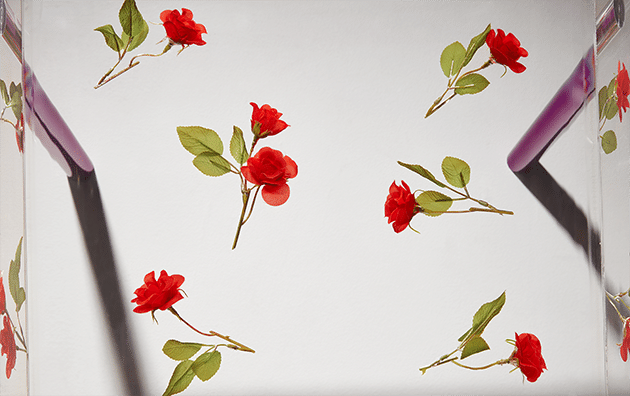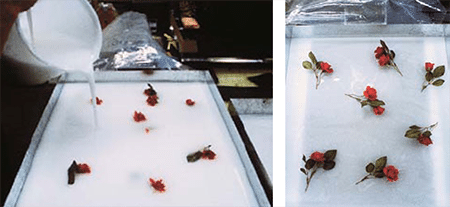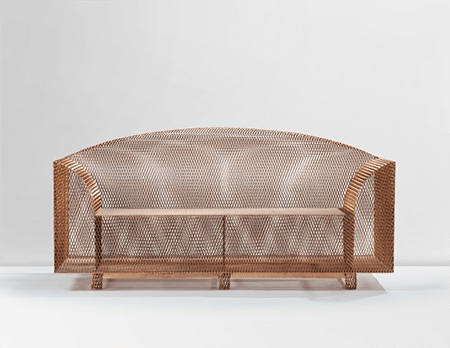Design
New York Auction 7 June 2022
1
Georges Jouve
Large "Cylindre" vase
Estimate $25,000 - 35,000
Sold for $32,760
Create your first list.
Select an existing list or create a new list to share and manage lots you follow.
2
Pierre Chapo
Table, model no. T21 D, and four benches, model no. S38
Estimate $7,000 - 9,000
Sold for $22,680
Create your first list.
Select an existing list or create a new list to share and manage lots you follow.
3
Josef Frank
"Flora" cabinet, model no. 852
Estimate $50,000 - 70,000
Sold for $138,600
Create your first list.
Select an existing list or create a new list to share and manage lots you follow.
4
Jean Prouvé
Set of six "Semi-metal" chairs, model no. 305
Estimate $40,000 - 60,000
Sold for $75,600
Create your first list.
Select an existing list or create a new list to share and manage lots you follow.
5
Georges Jouve
Pair of planters
Estimate $5,000 - 7,000
Sold for $6,930
Create your first list.
Select an existing list or create a new list to share and manage lots you follow.
6
Georges Jouve
"Cylindre" vase
Estimate $4,000 - 6,000
Sold for $5,040
Create your first list.
Select an existing list or create a new list to share and manage lots you follow.
7
Georges Jouve
"Boule" vase and two bottles
Estimate $18,000 - 24,000
Sold for $18,900
Create your first list.
Select an existing list or create a new list to share and manage lots you follow.
8
Georges Jouve
Pair of wall lights
Estimate $8,000 - 12,000
Sold for $37,800
Create your first list.
Select an existing list or create a new list to share and manage lots you follow.
9
Georges Jouve
"Boule" vase
Estimate $10,000 - 15,000
Sold for $20,160
Create your first list.
Select an existing list or create a new list to share and manage lots you follow.
10
André Borderie
Panel
Estimate $7,000 - 10,000
Sold for $5,670
Create your first list.
Select an existing list or create a new list to share and manage lots you follow.
11
Jean Prouvé
"Antony" chair, model no. 356
Estimate $15,000 - 20,000
Sold for $44,100
Create your first list.
Select an existing list or create a new list to share and manage lots you follow.
12
Alexandre Noll
Table lamp
Estimate $8,000 - 12,000
Sold for $56,700
Create your first list.
Select an existing list or create a new list to share and manage lots you follow.
13
Georges Jouve
"Cylindre" vase
Estimate $4,000 - 6,000
Sold for $9,450
Create your first list.
Select an existing list or create a new list to share and manage lots you follow.
14
Georges Jouve
"Cylindre" vase
Estimate $10,000 - 15,000
Sold for $16,380
Create your first list.
Select an existing list or create a new list to share and manage lots you follow.
15
Georges Jouve
"Cylindre" vase
Estimate $4,000 - 6,000
Sold for $5,040
Create your first list.
Select an existing list or create a new list to share and manage lots you follow.
16
Jean Prouvé
Set of four "Tout bois” chairs
Estimate $15,000 - 20,000
Sold for $32,760
Create your first list.
Select an existing list or create a new list to share and manage lots you follow.
17
Jean Prouvé
Sun shutter, designed for schools in Cameroon
Estimate $10,000 - 15,000
Sold for $13,860
Create your first list.
Select an existing list or create a new list to share and manage lots you follow.
18
Georges Jouve
Chalice
Estimate $6,000 - 8,000
Sold for $11,340
Create your first list.
Select an existing list or create a new list to share and manage lots you follow.
19
Jean Prouvé
Sun shutter, designed for schools in Cameroon
Estimate $10,000 - 15,000
Sold for $17,640
Create your first list.
Select an existing list or create a new list to share and manage lots you follow.
20
Jean Prouvé
Set of six "Semi-metal" chairs, model no. 305
Estimate $40,000 - 60,000
Sold for $52,920
Create your first list.
Select an existing list or create a new list to share and manage lots you follow.
21
Jean Prouvé
Cabinet, model no. 152
Estimate $30,000 - 50,000
Sold for $94,500
Create your first list.
Select an existing list or create a new list to share and manage lots you follow.
22
Georges Jouve
"Boule" vase
Estimate $4,000 - 6,000
Sold for $8,190
Create your first list.
Select an existing list or create a new list to share and manage lots you follow.
23
Georges Jouve
"Boule" vase
Estimate $18,000 - 24,000
Sold for $73,080
Create your first list.
Select an existing list or create a new list to share and manage lots you follow.
24
Jean Prouvé
Pair of "Semi-metal" chairs, model no. 305
Estimate $25,000 - 35,000
Sold for $34,020
Create your first list.
Select an existing list or create a new list to share and manage lots you follow.
25
Jacques Adnet and Jacques Lenoble
Coffee table
Estimate $8,000 - 12,000
Sold for $16,380
Create your first list.
Select an existing list or create a new list to share and manage lots you follow.
26
Jean Besnard
Low bowl
Estimate $1,000 - 1,500
Sold for $4,410
Create your first list.
Select an existing list or create a new list to share and manage lots you follow.
27
Alberto Giacometti
Pair of rare "Main Tenant une Coupe" wall lights
Estimate $200,000 - 300,000
Sold for $617,400
Create your first list.
Select an existing list or create a new list to share and manage lots you follow.
28
Jean Besnard
Table lamp
Estimate $6,000 - 8,000
Create your first list.
Select an existing list or create a new list to share and manage lots you follow.
29
Raymond Delamarre
"La Tentation"
Estimate $15,000 - 20,000
Sold for $32,760
Create your first list.
Select an existing list or create a new list to share and manage lots you follow.
30
Jean Besnard
Vase
Estimate $3,000 - 5,000
Sold for $8,190
Create your first list.
Select an existing list or create a new list to share and manage lots you follow.
31
Maison Jansen
Side table
Estimate $4,000 - 6,000
Sold for $5,040
Create your first list.
Select an existing list or create a new list to share and manage lots you follow.
32
Attributed to Joseph Urban
Pair of monumental candle holders, from the Mary and Joseph Urban residence, Yonkers
Estimate $8,000 - 12,000
Sold for $7,560
Create your first list.
Select an existing list or create a new list to share and manage lots you follow.
33
Émile-Jacques Ruhlmann
Bed, model no. 894b NR
Estimate $25,000 - 35,000
Create your first list.
Select an existing list or create a new list to share and manage lots you follow.
34
Gustav Gurschner
Two vases
Estimate $8,000 - 12,000
Sold for $10,080
Create your first list.
Select an existing list or create a new list to share and manage lots you follow.
35
François-Xavier Lalanne
"Mouton de Pierre"
Estimate $300,000 - 500,000
Sold for $529,200
Create your first list.
Select an existing list or create a new list to share and manage lots you follow.
36
Gustave Miklos and François Louis Schmied
"La Rivière Enchantée," unique paneled wall composition
Estimate $250,000 - 350,000
Create your first list.
Select an existing list or create a new list to share and manage lots you follow.
37
Jean Besnard
Vase
Estimate $4,000 - 6,000
Create your first list.
Select an existing list or create a new list to share and manage lots you follow.
38
Jean Besnard
Vase and footed bowl
Estimate $5,000 - 7,000
Create your first list.
Select an existing list or create a new list to share and manage lots you follow.
39
Jean Besnard
Large bowl
Estimate $4,000 - 6,000
Sold for $5,040
Create your first list.
Select an existing list or create a new list to share and manage lots you follow.
40
Ron Arad
"2RNot" chair
Estimate $20,000 - 30,000
Sold for $25,200
Create your first list.
Select an existing list or create a new list to share and manage lots you follow.
41
Hervé van der Straeten
"Volubile" ceiling light, model no. 306
Estimate $25,000 - 35,000
Sold for $40,320
Create your first list.
Select an existing list or create a new list to share and manage lots you follow.
42
Hervé van der Straeten
"Anneau" console
Estimate $25,000 - 35,000
Create your first list.
Select an existing list or create a new list to share and manage lots you follow.
43
Ron Arad
Monumental and unique "Blown Out Of Proportion (B.O.O.P.)" vase
Estimate $30,000 - 50,000
Sold for $40,320
Create your first list.
Select an existing list or create a new list to share and manage lots you follow.
44
Shiro Kuramata
"Miss Blanche" chair
Estimate $250,000 - 350,000
Sold for $516,600
Create your first list.
Select an existing list or create a new list to share and manage lots you follow.
45
Joris Laarman
"Bone" chair
Estimate $500,000 - 700,000
Sold for $630,000
Create your first list.
Select an existing list or create a new list to share and manage lots you follow.
46
Jun Kaneko
"Untitled" Dango form
Estimate $10,000 - 15,000
Sold for $24,570
Create your first list.
Select an existing list or create a new list to share and manage lots you follow.
47
Giovanni Ferrabini
Rare console table
Estimate $15,000 - 20,000
Create your first list.
Select an existing list or create a new list to share and manage lots you follow.
48
Betty Woodman
"Twisted Handle Vase with Shadow"
Estimate $15,000 - 20,000
Sold for $17,640
Create your first list.
Select an existing list or create a new list to share and manage lots you follow.
49
Ruth Duckworth
"Untitled"
Estimate $2,000 - 3,000
Sold for $3,780
Create your first list.
Select an existing list or create a new list to share and manage lots you follow.
50
Ruth Duckworth
"Untitled"
Estimate $4,000 - 6,000
Sold for $4,032
Create your first list.
Select an existing list or create a new list to share and manage lots you follow.
51
Gio Ponti
Wall-mounted chest of drawers, designed for the Hotel Royal, Naples
Estimate $30,000 - 50,000
Sold for $75,600
Create your first list.
Select an existing list or create a new list to share and manage lots you follow.
52
Gio Ponti
"Diamond" flatware service for 24
Estimate $18,000 - 24,000
Sold for $88,200
Create your first list.
Select an existing list or create a new list to share and manage lots you follow.
53
Gio Ponti
Side table with extendable leaves, from the "Domus Nova" series
Estimate $4,000 - 6,000
Sold for $8,190
Create your first list.
Select an existing list or create a new list to share and manage lots you follow.
54
Jean Puiforcat
Rare table clock
Estimate $12,000 - 18,000
Create your first list.
Select an existing list or create a new list to share and manage lots you follow.
55
Gabriella Crespi
“2000” extendable coffee table, from the "Plurimi" series
Estimate $30,000 - 40,000
Sold for $75,600
Create your first list.
Select an existing list or create a new list to share and manage lots you follow.
56
Corrado Corradi Dell'Acqua
Pair of "Montecarlo" side tables, model no. T 12
Estimate $2,000 - 3,000
Sold for $3,276
Create your first list.
Select an existing list or create a new list to share and manage lots you follow.
57
Gio Ponti
Dressing table, designed for the Hotel Royal, Naples
Estimate $5,000 - 7,000
Sold for $15,120
Create your first list.
Select an existing list or create a new list to share and manage lots you follow.
58
Gio Ponti
Pair of wall-mounted shelves
Estimate $15,000 - 20,000
Create your first list.
Select an existing list or create a new list to share and manage lots you follow.
59
Ico Parisi
Console table, model no. 1109
Estimate $15,000 - 20,000
Sold for $35,280
Create your first list.
Select an existing list or create a new list to share and manage lots you follow.
60
Doyle Lane
Weed pot
Estimate $5,000 - 7,000
Sold for $23,940
Create your first list.
Select an existing list or create a new list to share and manage lots you follow.
61
Doyle Lane
Weed pot
Estimate $4,000 - 6,000
Sold for $9,450
Create your first list.
Select an existing list or create a new list to share and manage lots you follow.
62
Doyle Lane
Weed pot
Estimate $5,000 - 7,000
Sold for $5,040
Create your first list.
Select an existing list or create a new list to share and manage lots you follow.
63
Doyle Lane
Weed pot
Estimate $4,000 - 6,000
Sold for $32,760
Create your first list.
Select an existing list or create a new list to share and manage lots you follow.
64
George Nakashima
Pair of "Conoid" lounge chairs
Estimate $10,000 - 15,000
Sold for $18,900
Create your first list.
Select an existing list or create a new list to share and manage lots you follow.
65
George Nakashima
"Greenrock" console table
Estimate $20,000 - 30,000
Sold for $30,240
Create your first list.
Select an existing list or create a new list to share and manage lots you follow.
66
George Nakashima
"Conoid" platform bed and "Conoid" headboard with storage
Estimate $18,000 - 24,000
Create your first list.
Select an existing list or create a new list to share and manage lots you follow.
67
Harry Bertoia
Rare "Sonambient" sounding sculpture
Estimate $20,000 - 30,000
Sold for $75,600
Create your first list.
Select an existing list or create a new list to share and manage lots you follow.
68
Harry Bertoia
Suspended gong
Estimate $25,000 - 35,000
Create your first list.
Select an existing list or create a new list to share and manage lots you follow.
69
Harry Bertoia
"Sonambient" sounding sculpture
Estimate $15,000 - 20,000
Sold for $21,420
Create your first list.
Select an existing list or create a new list to share and manage lots you follow.
70
Harry Bertoia
Suspended gong
Estimate $20,000 - 30,000
Sold for $16,380
Create your first list.
Select an existing list or create a new list to share and manage lots you follow.
71
Harry Bertoia
"Sonambient" sounding sculpture
Estimate $20,000 - 30,000
Create your first list.
Select an existing list or create a new list to share and manage lots you follow.
72
Harry Bertoia
Suspended gong
Estimate $25,000 - 35,000
Sold for $25,200
Create your first list.
Select an existing list or create a new list to share and manage lots you follow.
73
Harry Bertoia
"Sonambient" sounding sculpture
Estimate $12,000 - 18,000
Sold for $10,710
Create your first list.
Select an existing list or create a new list to share and manage lots you follow.
74
Harry Bertoia
"Singing bars"
Estimate $4,000 - 6,000
Sold for $3,780
Create your first list.
Select an existing list or create a new list to share and manage lots you follow.


